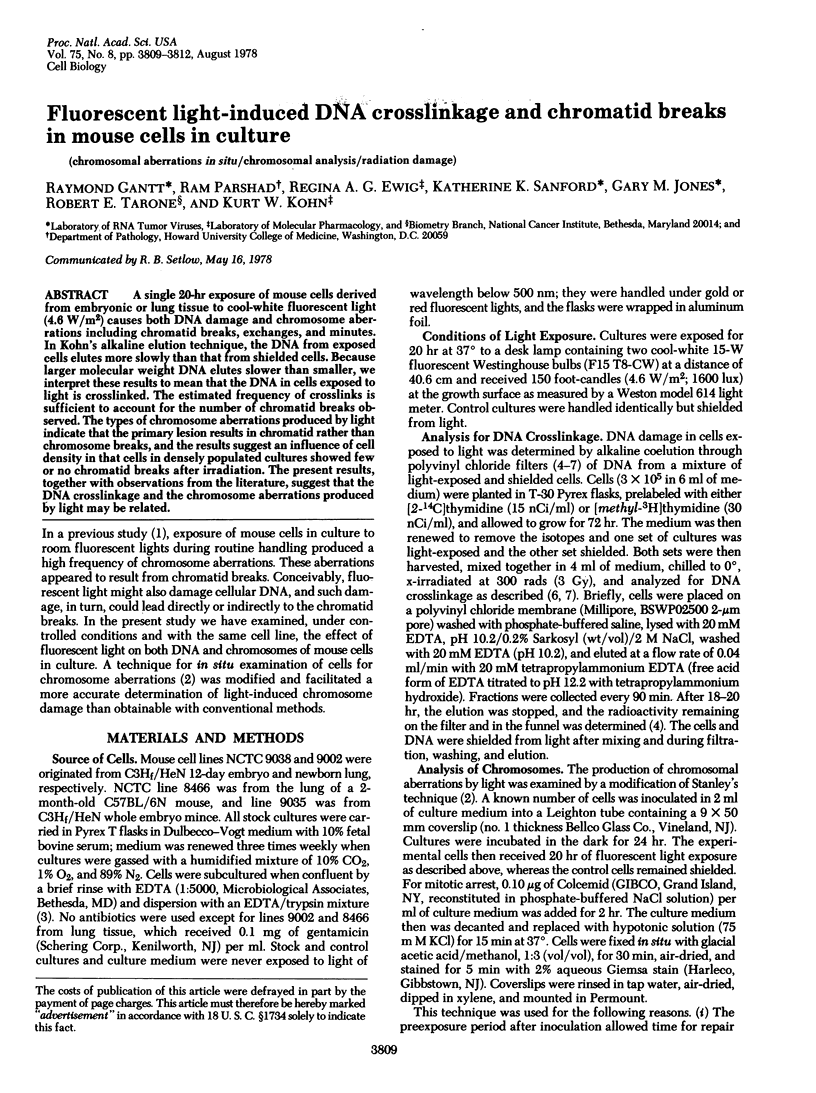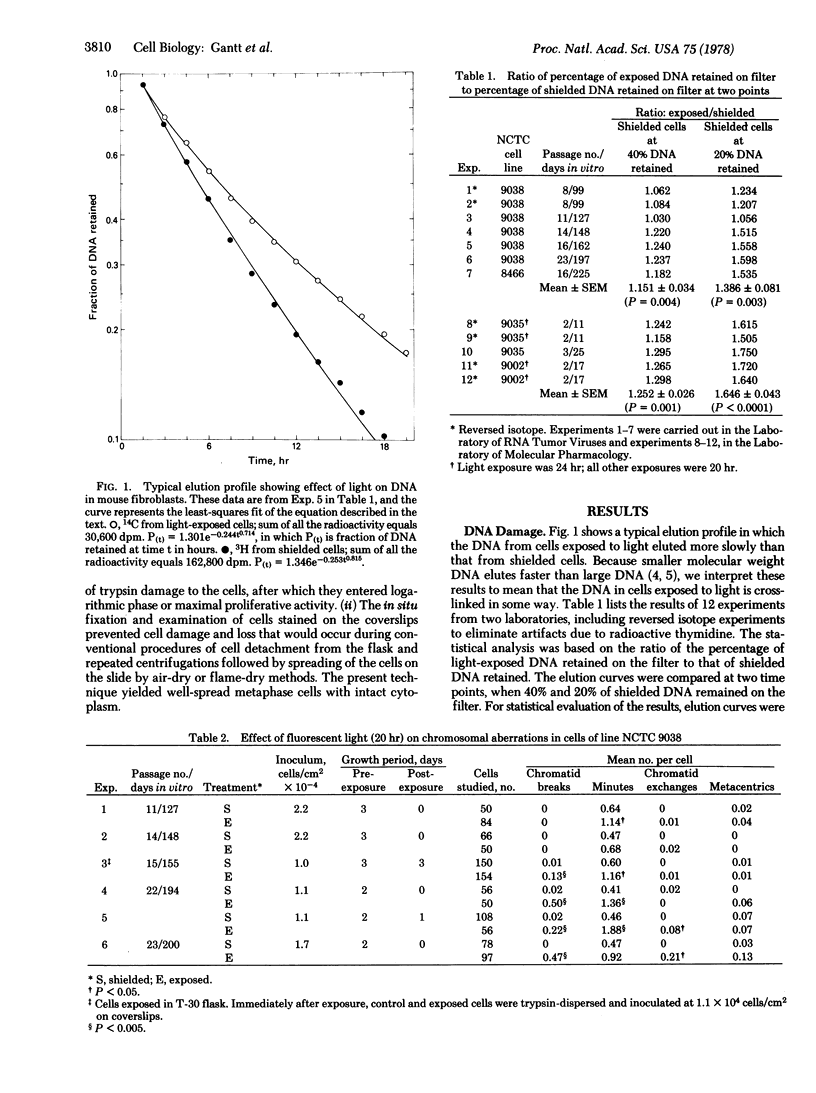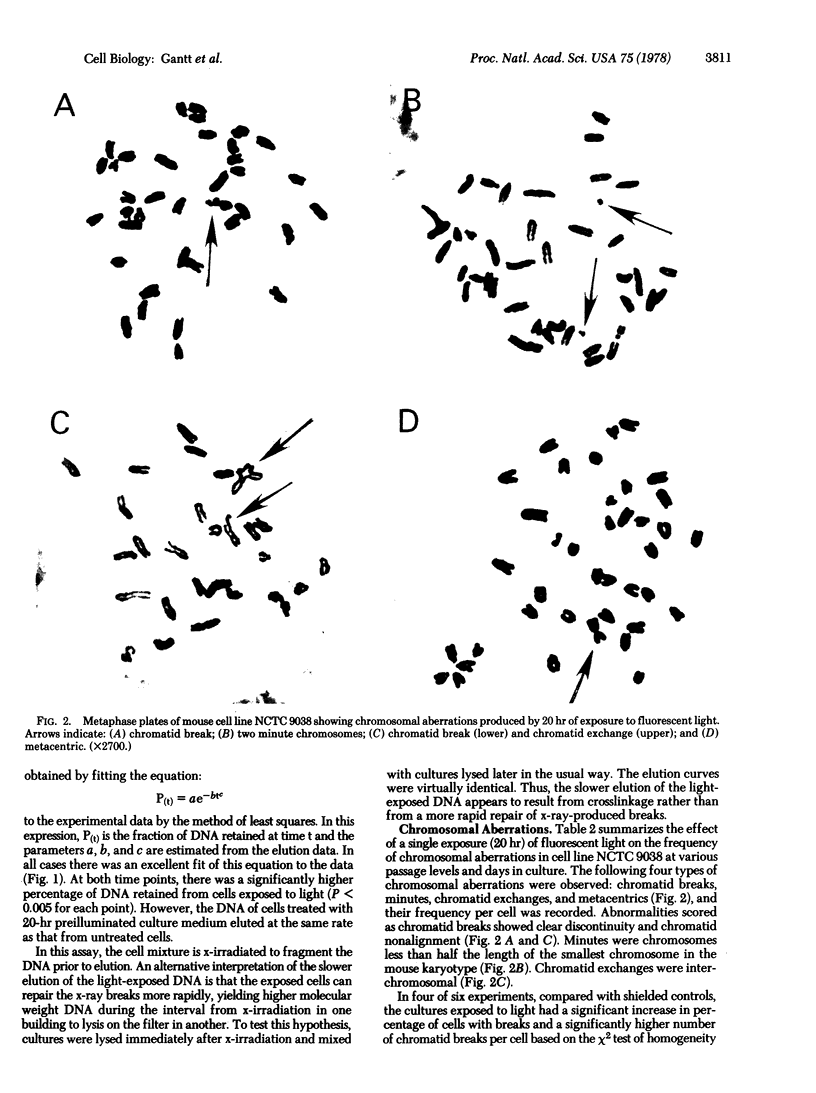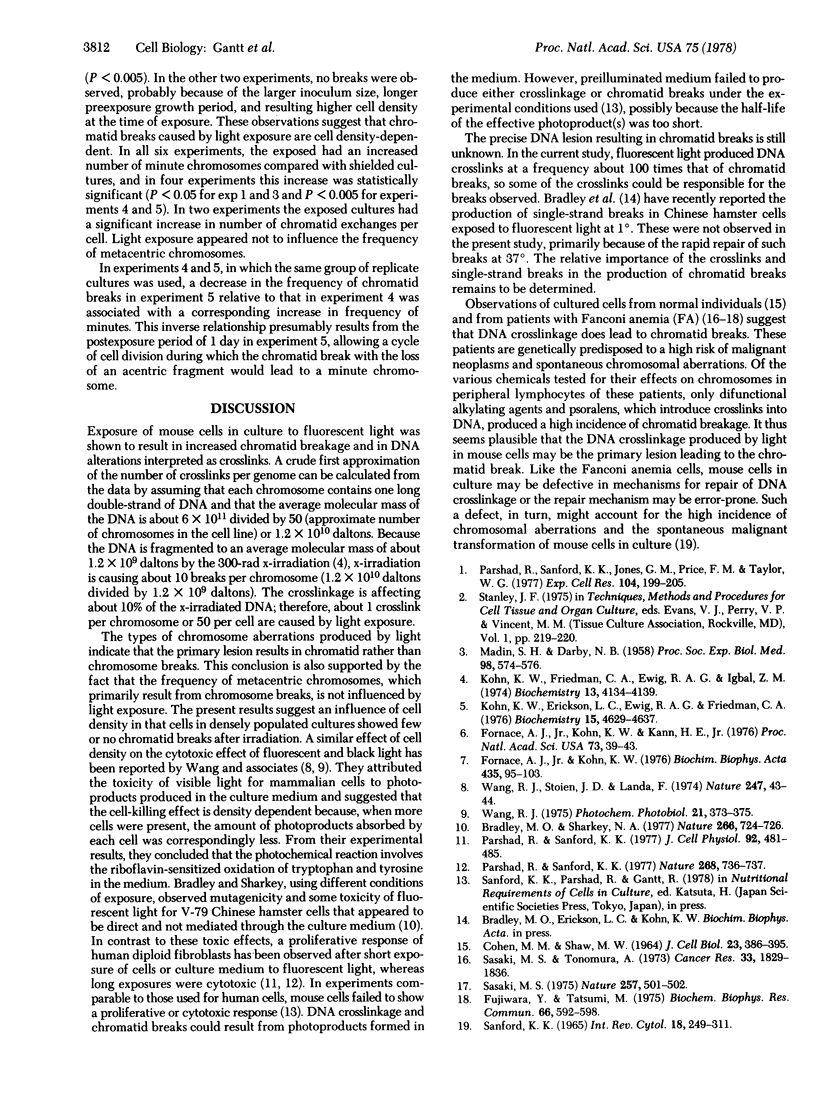Abstract
A single 20-hr exposure of mouse cells derived from embryonic or lung tissue to cool-white fluorescent light (4.6 W/m2) causes both DNA damage and chromosome aberrations including chromatid breaks, exchanges, and minutes. In Kohn's alkaline elution technique, the DNA from exposed cells elutes more slowly than that from shielded cells. Because larger molecular weight DNA elutes slower than smaller, we interpret these results to mean that the DNA in cells exposed to light is crosslinked. The estimated frequency of crosslinks is sufficient to account for the number of chromatid breaks observed. The types of chromosome aberrations produced by light indicate that the primary lesion results in chromatid rather than chromosome breaks, and the results suggest an influence of cell density in that cells in densely populated cultures showed few or no chromatid breaks after irradiation. The present results, together with observations from the literature, suggest that the DNA crosslinkage and the chromosome aberrations produced by light may be related.
Full text
PDF



Images in this article
Selected References
These references are in PubMed. This may not be the complete list of references from this article.
- Bradley M. O., Sharkey N. A. Mutagenicity and toxicity of visible fluorescent light to cultured mammalian cells. Nature. 1977 Apr 21;266(5604):724–726. doi: 10.1038/266724a0. [DOI] [PubMed] [Google Scholar]
- COHEN M. M., SHAW M. W. EFFECTS OF MITOMYCIN C ON HUMAN CHROMOSOMES. J Cell Biol. 1964 Nov;23:386–395. doi: 10.1083/jcb.23.2.386. [DOI] [PMC free article] [PubMed] [Google Scholar]
- Fornace A. J., Jr, Kohn K. W. DNA-protein cross-linking by ultraviolet radiation in normal human and xeroderma pigmentosum fibroblasts. Biochim Biophys Acta. 1976 Jun 2;435(1):95–103. doi: 10.1016/0005-2787(76)90196-9. [DOI] [PubMed] [Google Scholar]
- Fornace A. J., Jr, Kohn K. W., Kann H. E., Jr DNA single-strand breaks during repair of UV damage in human fibroblasts and abnormalities of repair in xeroderma pigmentosum. Proc Natl Acad Sci U S A. 1976 Jan;73(1):39–43. doi: 10.1073/pnas.73.1.39. [DOI] [PMC free article] [PubMed] [Google Scholar]
- Fujiwara Y., Tatsumi M. Repair of mitomycin C damage to DNA in mammalian cells and its impairment in Fanconi's anemia cells. Biochem Biophys Res Commun. 1975 Sep 16;66(2):592–598. doi: 10.1016/0006-291x(75)90551-3. [DOI] [PubMed] [Google Scholar]
- Kohn K. W., Erickson L. C., Ewig R. A., Friedman C. A. Fractionation of DNA from mammalian cells by alkaline elution. Biochemistry. 1976 Oct 19;15(21):4629–4637. doi: 10.1021/bi00666a013. [DOI] [PubMed] [Google Scholar]
- Kohn K. W., Friedman C. A., Ewig R. A., Iqbal Z. M. DNA chain growth during replication of asynchronous L1210 cells. Alkaline elution of large DNA segments from cells lysed on filters. Biochemistry. 1974 Sep 24;13(20):4134–4139. doi: 10.1021/bi00717a011. [DOI] [PubMed] [Google Scholar]
- MADIN S. H., DARBY N. B., Jr Established kidney cell lines of normal adult bovine and ovine origin. Proc Soc Exp Biol Med. 1958 Jul;98(3):574–576. doi: 10.3181/00379727-98-24111. [DOI] [PubMed] [Google Scholar]
- Parshad R., Sanford K. K. Intermittent exposure to fluorescent light extends lifespan of human diploid fibroblasts in culture. Nature. 1977 Aug 25;268(5622):736–737. doi: 10.1038/268736a0. [DOI] [PubMed] [Google Scholar]
- Parshad R., Sanford K. K., Jones G. M., Price F. M., Taylor W. G. Oxygen and light effects on chromosomal aberrations in mouse cells in vitro. Exp Cell Res. 1977 Jan;104(1):199–205. doi: 10.1016/0014-4827(77)90082-9. [DOI] [PubMed] [Google Scholar]
- Parshad R., Sanford K. K. Proliferative response of human diploid fibroblasts to intermittent light exposure. J Cell Physiol. 1977 Sep;92(3):481–485. doi: 10.1002/jcp.1040920315. [DOI] [PubMed] [Google Scholar]
- Sanford K. K. Malignant transformation of cells in vitro. Int Rev Cytol. 1965;18:249–311. doi: 10.1016/s0074-7696(08)60556-2. [DOI] [PubMed] [Google Scholar]
- Sasaki M. S. Is Fanconi's anaemia defective in a process essential to the repair of DNA cross links? Nature. 1975 Oct 9;257(5526):501–503. doi: 10.1038/257501a0. [DOI] [PubMed] [Google Scholar]
- Sasaki M. S., Tonomura A. A high susceptibility of Fanconi's anemia to chromosome breakage by DNA cross-linking agents. Cancer Res. 1973 Aug;33(8):1829–1836. [PubMed] [Google Scholar]
- Wang R. J. Lethal effect of "daylight" fluorescent light on human cells in tissue-culture medium. Photochem Photobiol. 1975 May;21(5):373–375. doi: 10.1111/j.1751-1097.1975.tb06688.x. [DOI] [PubMed] [Google Scholar]
- Wang R. J., Stoien J. D., Landa F. Lethal effect of near-ultraviolet irradiation on mammalian cells in culture. Nature. 1974 Jan 4;247(5435):43–45. doi: 10.1038/247043a0. [DOI] [PubMed] [Google Scholar]






